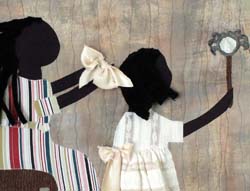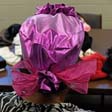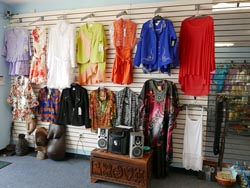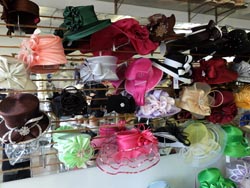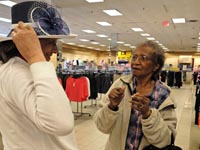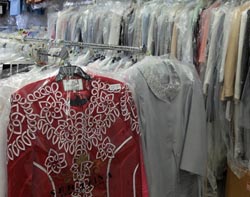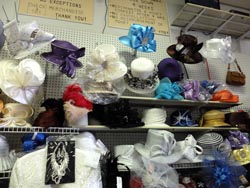Living in Style: The Language of Hats
By Laura Marcus Green
The saying is, and it's true—
a lady is never dressed without a hat.—Aldreamer Smith, Sensational Seniors,
Dr. Leo S. Butler Community Center

The Language of Hats
Overview
For many African American people, the mere mention of hats brings a smile. Those who wear them—mostly women in their fifties and older—love to talk about their hats. For others, hats are a springboard for nostalgia, evoking mothers, aunts, and grandmothers. Hats are associated with church attire, but they are also worn at weddings, baptisms, communions, graduations, funerals, and teas, among other occasions. A full outfit is a top-to-toe affair, from the hat and dress or suit on down to the purse, jewelry, and shoes.
Research with three prominent Baton Rouge milliners shed light on the place of hats and fashion in people's lives and on a business that resonates deeply with customers' experience and heritage. In Baton Rouge, those shopping for hats and apparel can choose among several boutiques. Milliners interviewed for this project include Nomzamo Iyanu of Nomzamo's Boutique, Tony Aguirre of Variety Fashion, and Mu Kyong "K" Dickerson of Four Seasons Hat & Wigs. Each of their shops has its own feel and specialties, and a devoted clientele.
The picture of the hat business and hat-wearing traditions would be incomplete without hearing from those on both sides of the counter—from the milliners and their customers, those who actually wear hats. Interviews with several women in the community gave insight into both the broader cultural practice and the individual expression of hat wearing. Miss Jescenia Crenshaw of Denham Springs is of a generation who grew up wearing hats and who continues to wear them. Other interviewees represent shifts in hat wearing traditions since their mothers' and grandmothers' times. They include Susan Thornton—Miss Crenshaw's daughter, and First Lady Millie Green of the New Salem Missionary Baptist Church.1 Jacqueline Jones, Associate Dean of the Learning Resource Center/Library at Baton Rouge Community College, has revived the art of wearing hats, both in her own attire and as part of an intergenerational curriculum she offers at area churches and other venues. Dafiney Self of Chaneyville, a retired art teacher who directs the arts and crafts program at the Chaneyville Community Center, has applied her talents to making hats for herself and others.
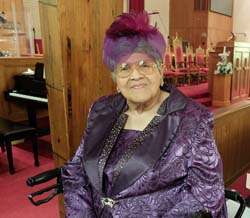
Easter is among the most important hat-wearing seasons of the year. Coinciding with the two weeks leading up to Easter 2015, the research presented here offered opportunities to experience the bustle of the milliners' shops at this special time and to attend several seasonal hat-wearing occasions. These included Palm Sunday and Good Friday services at the Shiloh Missionary Baptist Church and an Easter program put on by the Sensational Seniors group at the Dr. Leo S. Butler Community Center. Research with milliners and community members alike led to the same conclusion: hats speak volumes about the women who wear them and about the evolving social and cultural contexts in which they are worn.
A Time to Wear Hats: Historical Context
The tradition of wearing hats to church can be traced as far back as the Bible. From the Apostle Paul comes this proclamation, set forth in I Corinthians 11:5, "But every woman that prayeth or prophesieth with her head uncovered dishonoureth her head." Beyond their spiritual implications and their practical role in protecting wearers from the sun and heat or cold, hats hold historical significance in Louisiana, where in 1786, a Tignon Law prohibited both free and enslaved women of color from wearing hats. "Tignon" [pronounced tee-YONE] refers to the cloth turbans or headdresses that were worn by women of color during that time. Set in its social context, the Tignon Law figured into a broader restrictive framework imposed upon African Americans. Writing about this era and its impact on future generations, Elaine Nichols has observed,
Beginning in the eighteenth century, dress was a contested issue that pushed Southerners to attempt to regulate the appearance of enslaved African Americans through laws. Generally known as sumptuary laws that applied broadly to everyone's personal spending, and moral and religious behaviors, Southerners placed specific limitations on Negroes. These codes restricted Black dress to coarse and inferior materials commonly called "Negro cloth" and prohibited African Americans from wearing "finer cloth." These ideas about distinguishing racial and class differences persisted through the end of slavery, even as Blacks continuously resisted and subverted the standards.
Over time and across space, African American women have used the adornment of their bodies as an individual and collective canvas of cultural expression. They have created identities and beauty of their own making. Their clothing, hair, and accessories have served as concrete and visual representations of an emblematic statement to the world that their presence matters.
Before the Tignon Law was repealed in 1843, women of color found ways around it, even while staying within its bounds. Tignons were tied in elaborate and imaginative styles with colorful cloth of the highest possible quality, often embellished with jewels, ribbons, and other adornments. When the law was repealed, the wearing of hats in African American communities took on heightened significance, as women were liberated to fully express themselves with hats.
Jacqueline Jones, Associate Dean of the Learning Resource Center/Library at Baton Rouge Community College, has researched African American hat traditions. She writes:
It was in the 20th century that the black woman really set the bar in hat wearing. It was the hat that symbolized who she was, who she could be, or who she wanted to be; a woman of class and dignity. Historically, she was depicted in tattered clothing, work uniforms or homey style dresses. So, if only for one day a week, the black woman could feel special. She could be obedient to God's word, and cover her head, (1: Corinthians 11:5) while presenting herself in Godly ways, in behavior and apparel. It was a certain behavior required when adorning a hat. It was attitude. Ladies today refer to it as Hattitude.
Hat wearing was meaningful to the black woman; a privilege once denied, unleashed. She merely took it to another level. After all, she worked hard, loved and took care of her children and family. She had the desire to feel worth and value as any woman. Her goal was to pass this sense of pride and dignity to her children. Simply put, the black woman did not let the world define her, she defined her world.2
Today, Tignon wraps are making a comeback in Louisiana and beyond, as women reclaim this tradition on their own terms, while paying tribute to their heritage and history—and to the women who found ways to express their beauty, individuality, and resourcefulness, even in adversity. Nomzamo Iyanu sells head scarves in her boutique, and teaches her staff and customers how to wrap them. She points out that, whereas a hat can only be worn one way, scarves can be tied in different styles, so they offer versatility.
Living in Style: Hat Wearing Traditions
When the Apostle Paul wrote an open letter to the Corinthians (I Corinthians 11:5), decreeing that a woman cover her head when at worship to symbolize her obedience to God and the church hierarchy, he could not have imagined the flamboyance with which African American women would comply. For generations, black women have interpreted Apostle Paul's edict with boundless passion and singular flair, wearing platter hats, lampshade hats, why'd-you-have-to-sit-in-front-of-me hats, often with ornaments that runneth over.
—Michael Cunningham,
Crowns; Portraits of Black Women in Church Hats
While some women wear hats to church every week, others wear them only on holidays like Easter, Mother's Day, Christmas, and other sacred or secular occasions. According to milliner Nomzamo Iyanu,
Oh, they wear hats to teas. They wear hats to wedding showers. Of course, to church. . . . You know, because you have the fun hats, too, that you wear. So they wear hats to picnics and things of that nature. Where else? Just like, going shopping. That lady [a customer in Nomzamo's] had on that little hat with the little rhinestones on it, and it was a casual hat. And we sell stuff like that, too, little casual hats. And we wear hats if we think we're having a bad hair day. Put on a hat and it looks good, you know. So just different occasions.
Women are more likely to wear hats to church for special events like Women's Day, a tradition in many African American churches, or for their church's or pastor's anniversary, sometimes called Appreciation Services. On Women's Day, women fill all the duties for the church on a given Sunday, providing the music, the sermon, and collecting money, among other tasks. Jacqueline Jones explains the significance of Women's Day:
Women basically take over all of the roles and responsibilities for the Women's Day church service. Any monies collected during the offertory that day are dedicated to whatever current church project the women would like to support. Right now at our church, for example, we are working on developing a youth activity center where we can hold tutoring sessions and address many of the concerns of our youth. In raising these Women's Day funds, the women of our church are in essence saying to the rest of the congregation, in addition to our tithes, here is some extra money that we would like to donate towards our church's current project.
Nomzamo points out that on Women's Day, "The ones who do wear hats, wear hats, and maybe the ones who don't normally wear a hat might break out in a hat: 'Let me break out in a hat. They don't expect me to and I know some of these women are going to have hats on. Let me get me a nice hat.'"
Fifth Sunday is also a time when those who do not normally wear hats to church might sport a hat. Church ushers pass the offertory basket each week and do not wear hats, as a rule. When there is a fifth Sunday in the month, church ushers take a break from their regular responsibilities, and so have an opportunity to wear hats.
Some churches host Hat Days. Hat Day typically involves a competition in which participants vie for the most innovative hat, among other categories. Often, Hat Day serves as a church fundraiser or is part of a social or civic program. First Lady Millie Green reports that at New Salem Missionary Baptist Church's Hat Day, women invite guests to attend church and sit in their pew, wearing a hat. The "hostess" of each pew passes an envelope to her guests so that they can contribute to the fundraiser. For the competition, three mystery judges select the women with the three most beautiful hats. Millie has seen events called Hattitude advertised in the Saturday paper. When she reads these notices, she assumes that it means, "Ladies wear your hats! And you wear it according to your personality, and with how your attitude is for that day."
Born in 1930, Jescenia Crenshaw is a lifelong member of the Mount Hope Baptist Church in Denham Springs. As a child, she rode to church with her family in a mule-drawn wagon. In her early years, she balanced school and agricultural work, completing the tenth grade before entering the work force full time. Today, she is retired. Previously, she did domestic work. By day, she cleaned people's homes and cared for their children. She cleaned a dentist's office at night. This is how Jescenia and her husband managed, with many children to feed, clothe, and send to school. She is grateful that her children attended college and are all doing fine for themselves today.
For women of Jescenia's generation, wearing hats has been a family tradition. She recalls,
Yes, yes, my mother wore a hat. I do have some of my mother's old hats. And they wore their hats to church, they certainly did. And that's not the reason why I wear hats—because my mother and my grandmother, and all the old people wore the hats. I just like a hat. To me, when I go into church, it does something for me. . . . It just makes me happy. And I wear my hats and I love them.
Jescenia grew into the hat-wearing tradition as she came of age. She does not wear hats every Sunday, but she does on occasions like Communion Sunday, religious holidays like Palm Sunday, Easter Sunday or Christmas services, and special events at her church.
As a little girl, I didn't wear hats. I wore hats as I got married and started having a family. And going to church with my family, I began to wear hats. And I'm wearing the hats today, but not every Sunday. The only time I wear hats to church is when we have some kind of a rally or a special program going on, and on Communion Sunday, by all means. And usually when we have something going on at our church, where we ask the visitors from the other churches to come. And the senior citizens who visit have on hats. But not young people—they don't wear hats. But we wear our hats.
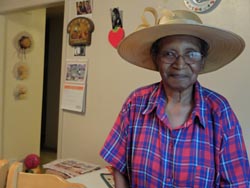
When putting together an outfit for church, where does Jescenia start? She explains,
I get out my dress. And I look at the colors on my dress. And then I go from that, then I know what color shoes to wear, and I know what color hat to wear, and I know what color purse to wear. We used to wear gloves, but not anymore. We don't wear gloves any more. But when you see someone come into church with those gloves on, and that hat, and that outfit and those shoes, and that purse—it looks so good when they come into church. Yes indeed.
Hat wearers make decisions based on individual preferences and sense of style. For example, some match their colors, while others go for contrast among their wardrobe components. Jescenia matches the pieces in her outfit. "If it's a green dress, I match up with the green. And if it's it a red dress, I match it with the red. I love red. That's my color." Interestingly, Jescenia does not own a red hat. When she wears one of her red dresses, she dons a neutral-colored hat, such as white, black, or brown, often harmonizing with a color in the dress.
Nomzamo Iyanu sees a range of preferences among her customers. As a milliner, she is attuned to her customers' varying tastes, and stocks her inventory accordingly. She shares what one customer told her,
"My suits have to match my hat. That's how I walk." You know, so that means she's matchy, she wants to make a statement. And that statement is that, "I'm organized, I'm categorizing my outfit. Bling here, bling there. It's working. You know, everything is in order." Whereas you have some people, they like to mix and match stuff, you know? You know, bold here, plain there. Or bold there and plain here.
Tony Aguirre of Variety Fashion also finds diverse tastes among her customers. She orders her hats from catalogs. The manufacturers with whom she does business create their own hats to go with their suits, so she buys whole ensembles. Tony finds that some customers like buying a whole set, while others buy the hats or suits individually. She knows she is always taking a chance when she buys the matching suits and hats. Sometimes the pieces go their separate ways. Mu Kyong "K" Dickerson, owner of Four Seasons boutique, orders her hats and outfits separately from a catalog. There is always a moment of suspense when opening the boxes when they arrive from the manufacturer. K can tell right away whether the hats and outfits will work together.
There are also many choices in hat styles. According to Nomzamo, not every hat design has a name but there are categories: "Hats with brims, big brims, short brims, wide brims, long brims, long wide, ring hats," and so on. A hat's shape and size figure into personal preference and style. In Nomzamo's experience, whereas some people favor smaller hats,
You have other people who are thinking, "It has to talk. It has to have a loud conversation." And you just kind of go through the process with them, you know? You've got to have all of those conversations. You can't have just huge hats or just little hats or just ring hats in the store. . . And the hats, they talk. They have conversations like, okay, "You look sophisticated, very conservative," and so on.
Tony Aguirre agrees: "It all depends on the individual. Some people like big hats, some people, they like the small hats." At the time of her interview, Tony noticed a trend towards larger hats. A person's size may determine her choice of hats. A tall person looks gorgeous in a big hat, for example, but not a short person. Nomzamo points out that people wear hats strategically: "If you're a tall person, it elongates you. If you're a short person, it gives you height." Susan Thornton, Jescenia's daughter, recalls her childhood, when all women of her mother's generation wore hats,
Back then, depending on their body style, some people who were maybe a little bit thicker might have wanted a skinny hat; maybe they didn't want to look all wide all the way, maybe they wanted to draw their body in. It depended on the type of hat. For some people, it depended on the face, whether they wanted a wide hat or if they wanted a tall, narrow hat to take away from roundness of the face. Some people had their favorite colors that they like. Some people had their favorite hat designers of the hat, or their favorite hat shop where they would shop. So, your hat dealt a lot with the individual and her personality.
Asked what makes a good or beautiful hat, Jescenia replies, "Well, I would say, it's the colors and the way the hat is made. To me, I like a round hat, with the round bottom on it. And maybe a bow or a flower. I don't like a plain hat, with nothing on it, just an old hat, say, to wear to church. But to wear it just, say, anywhere, that's alright, an old everyday hat. I have some of those, too." During the week, on her walking excursions for exercise or shopping, Jescenia wears a straw hat with a big brim on it. Over the years, she has mostly worn the same style hat. She favors a hat with a wide rim, but not so wide that she cannot see when she looks down.
Jescenia Crenshaw and her daughter Susan Thornton embody the dramatic shift between their generations. For women of Susan's generation, hats have become less of a fashion statement and more a source of nostalgia and a sign of changing times. Susan Thornton grew up in Denham Springs and moved to Baton Rouge after marrying. She is a specialist at I Care, an alcohol, drug abuse, and violence prevention program of the East Baton Rouge School System. She considers herself fortunate to have two mothers. Jescenia Crenshaw is her biological mother, however Susan was raised by her adoptive mother, the late Inez Scott. Inez Scott is the person to whom Susan refers as "Mama."
For Susan, hats are a connection with both of her mothers. She recalls from her childhood,
When I was growing up I remember that hats were what was called "a lady's adornment," you know, they would be in church and they would always wear a hat. And it didn't matter whether it was a fancy hat or the plain hat because on some Sundays, especially on first Sundays, the ladies would wear white hats. And sometimes they would all be plain white hats, without a lot of feathers or rhinestones. But then on other Sundays, on Easter, on Christmas, on Mother's Day or any type of special holiday, the ladies would go all out to get the fanciest hats. It was, who had the fanciest hat and who had the suit to go with the fancy hat. So, the hat was one of the driving statements for the outfit.
Susan shares a saying from her mother's generation: "The bigger the better, the longer the feather."
First Lady Millie Green of the New Salem Missionary Baptist Church was also raised with a strong hat-wearing tradition. Millie grew up in Princeton, in northern Louisiana. From there, she attended Grambling State University, where she met her husband, Pastor Willie J. Green, Jr. When the couple married, they moved to Baton Rouge. Growing up, Millie attended New Hope Baptist Church and participated in Sunday school, the choir, vacation Bible school, and Baptist Training Union—all of the early traditional religious education programs. Women of all denominations wear hats to church, but Millie's impression is that Baptist women are especially fond of dressing up for church. "We have a tendency to wear formal clothing—you know, suit, heels, purse, hats. I grew up with that. My mom had her hats, her suits, and her heels and stockings, you know. Today, a lot of people don't wear the stockings."
Millie has vivid memories of her childhood and the women who dressed for church. "They all matched—the suits and the hats matched. They were big—mostly large hats, and not the small ones so much. The brims were wider. And they were high—yeah, yeah, yeah. Easter was the most exciting time, when you had all of your bright colors on, with your hats and purses and everything."
Nomzamo Iyanu recalls from her childhood in Ville Platte, Louisiana,
My grandmother never went to church without a hat. You just didn't do that. She wore big hats. She was a steward, and so they wore hats all the time. And if they had on a hat, they had the little veil on it. So, I can remember those times—the grandparents and parents always wore a hat. And the ladies in the church adorned with hats.
Dafiney Self of Chaneyville was born and raised in the community where she lives today. She left Chaneyville briefly for her first teaching job at Pineville High School in Alexandria, Louisiana, and stayed in the area, teaching high school art, until she married in 1972 and returned to her hometown. After earning her Master's degree in early childhood education, she eventually took another teaching job in Jackson, from which she eventually retired. She also holds MA's in Art Education and Administration and Supervision, all from Southern University.
Dafiney attends Mt. Pleasant Baptist Church, her home church from childhood days. From her youth, she remembers, "Everything my mother wore to church was starched and ironed. And a little hat to match. Perhaps they didn't pay very much for it, but they took good care of what they had."

Dafiney recalls the hat styles from earlier generations as "just little simple hats that they would wear, probably with a bow on the side, and that was it. Something that they could afford." Dafiney does not remember seeing many colorful hats during her childhood. Since people did not have very much money back then, the hats were traditionally either black or white because they would go with any outfit. The hats of that era in her community were of a round design, but not with a wide rim because people probably could not afford anything too fancy. In her memory, the stewards' hats were white, perhaps with a little hairpin to hold it in place, in the style of the day. Dafiney remembers that people typically wore the same hats to church each week because that was probably all that they had. First Lady Millie Green likewise remembers that at her childhood church, women's hats were mostly black, brown, cream, and tan. She notes that today's hats are more colorful and diverse in styles and shapes.
Traditions in Transition: Generational Shifts in Hat Wearing
The women interviewed for this project recall that as little girls, they dressed for church and some even wore hats for special occasions. With the exception of Jescenia Crenshaw, who represents an earlier generation, these women experienced a marked decline in the once-prevalent hat-wearing tradition as they came of age. Today, you might see only a few women wearing hats to church or at other occasions where women have traditionally worn hats.
Looking back, Susan Thornton remembers that she always wore bows in her ponytails for church and school. She had two or three bows that she wore regularly. Her mother had one special little bow that was only for church, along with her church shoes and dress. Susan reflects, "You could only afford so much, and you had to look nice." Jacqueline Jones recalls her mother "as a hat-wearing, glove-wearing person." Her mother did not insist that Jacqueline and her siblings wear hats every Sunday, but for Easter and special days, "We had hats, even the gloves and lace socks." Nomzamo Iyanu, Jacqueline's sister-in-law, agrees, "Yes indeed!"
Millie Green does not remember wearing a hat to church as a little girl. Since she sang in the choir, she would not have worn a hat on most Sundays. But for Easter, she might have worn a little hat. She remembers that at Easter time, people would put on what they called their "Easter flock." "So that was your pretty dress, you know, all frilly and looking real girly. And you had your hat. And of course, the younger ones, if they didn't have a hat, they had pretty bows in their hair. So that made it special, real special."
Dafiney Self recalls, "No, we didn't have any hats. My grandmother had bows and things they would put in our hair. We wore the bows, the big bows during that time. They made them out of cloth, whatever they had. And so that's what you wore in your hair." Dafiney remembers that often, girls' matching bows were made from the same cloth as their dresses, typically the vividly printed flour-sack cloth that was repurposed into clothing.
Dafiney continues, "We mostly walked to church because we didn't live too far from the church. And you walked to church, and you had on your starched and ironed little pleated skirts that your grandmother made and your top. And you had to sit in church and you had to act like a young lady. And you had to follow your parents' steps, whatever they told you. People dressed in whatever they had. But they looked nice in what they wore during that time."
Why was it important to look good for church? According to Dafiney,
Well, being from the country, that was the only place a lot of people had to go. Because very seldom did you go downtown [to Baton Rouge]. You had no transportation, or you had no way of getting there. Church was where we had what people called Homecoming, where people would dress. You had baptisms, you know, where people got baptized. We had a pool, just a little concrete pool out in the front of the church. If you got baptized, that's where you got baptized, and everybody would come see you. And you would dress in your nice little outfit that your grandmother made. And you wanted to look nice.
Reflecting on changes in hat wearing since her youth, Dafiney observes,
Ever since I was a child, the older women wore their nice little hats and their little dresses. And you know, that was their tradition. But today, not too many people wear hats. Only the older ones, and maybe some younger ones who are getting back to that. It's getting back into the custom, but a lot of people don't wear hats anymore. . . . You have a different type of generation. A different type of group that's growing up now. The younger generation, they say, "Oh that's from the old school," or whatever. But I see some younger women now, trying to get their tradition back. But throughout my generation, that's what the older women wore.
Susan Thornton has seen dramatic changes in clothing styles since her youth. She recalls,
We didn't have that come-as-you-are attitude when I was coming up in church, because come as you are meant you were going to dress. We called it "Sunday best." You're going to wear your Sunday go-to-meeting clothes. So, there was no coming as you are in tennis shoes or pants. We couldn't wear that back then. Today we do. But not back then. So, things have changed. Even though economically it was very stressful and hard for my parents and everybody else who was in my church, we made it happen. We made it happen. So there was a pride, too.
Susan recalls the ritual of preparing for church in her childhood home:
A lot of things that we were doing growing up were about school and sports, but it was also getting ready for Sunday. You got to lay your clothes out, you know. And with my mom, the hat was just part of it. Her hat was my shoes. I had to lay out my shoes, which, I only had one or two pair of shoes. But for her, she had us set up in the closet, and she'd say, "Baby, let me see, what hat do I want to wear Sunday?" I'd say, "I don't know, Mom, what about that?" "Oh no, I'm not going to wear that one."
Often, Susan helped her mother pick out her hat for Sunday. On such occasions, Susan would think to herself,
Oh, I can't wait to do that. But I didn't do it. Not really. My impression was that I thought she was beautiful, gorgeous, I couldn't wait to go to church and show her off. But that was something that I saw as a baby. And it was just the way it was, it was our custom, it was our tradition. That's what we did. That's what we did in our home, then out in the community and to the church—that's just the way it was. Ladies did not go to church without something on their head. And on the Sundays when we took communion, the ladies would wear white hats. We had to put white handkerchiefs on our heads, because you couldn't take communion without something on your head. Now that was tied into religion. That was tied into the belief. But my mom would wear a certain type of hat; she would wear a white hat. And she never would remove her hat in church. You don't take your hat off in church.
The girls would put the handkerchiefs on their heads just for ten minutes, while they took communion.
As a child, Susan assumed that she would wear hats and a lot of jewelry when she grew up, just like her mother. But as an adult she finds that the styles favored by her mother's generation are not for her. She wears hats in the winter when she goes to sporting events, but she does so out of practicality—to protect her hair, to protect her sinuses, and to keep from getting cold. These hats come off when she goes indoors. Susan does not wear a hat to church. Occasionally, she wears a headband as part of an outfit. She sees her hat wearing as totally different from the way her mother wore hats. Susan explains the difference between her mother's and her own generation:
Our hair is our pride, our crown, our top, as the hats were for my mom. They would call them their crowns, their tops, their pride. It's our hair, for our generation. So I'm not going to put anything on top of it because this is what I want you to see. As for my mom, they worked all week. My mom didn't go to the beautician. Number one, she didn't have time. And she didn't go to the beautician like we do. You know, I have a standing appointment where I'm going to get my hair done. But my mom couldn't afford that, so you had to have something to cover what they would probably call "a mess," or "a bad hair day." Yeah, there were lots of reasons why they wore that hat.
Dafiney Self remembers wearing a hat to church for the first time when she was in eleventh grade, for her grandmother's funeral. Dafiney was very close to her grandmother, who taught her to sew and was among the inspirations for Dafiney's life working in the arts. Dafiney thinks that her mother was likely responsible for her wearing a hat to her grandmother's funeral. She remembers, "It was something I had never done before, and it just felt different, since I was not an adult. Because it was mostly the adults who wore hats, not the children."
Dafiney did not begin wearing hats after her grandmother's funeral, but as an adult she often wears a hat to church or to a special occasion like a funeral. The hats she wears to church are smaller round hats, or flat hats with a bow. She also favors headband-style hats. A talented artist and seamstress, she custom-makes hats, both for herself and for those lucky enough to be in her circle of friends and family. Of her sense of style she says,
It's something simple, something that you can put on easily. Now, I do wear the ones with the fleece for the winter, for the coldness, since we have all types of weather around here. I make my own bows. I like to match them with the buttons. I like to match different designs. Also, for the ones that I make, I use the netting, like what the older women wore with the little netting that comes over their little hat.
First Lady Millie Green's first memory of wearing a hat is as an adult, for a Hat Day event at New Salem Missionary Baptist Church to which all the women were asked to wear a hat. She recalls,
It was interesting, because even those who had never worn a hat before—me, for one—would wear it. There were special occasions where I did wear a hat. I'm not an every-Sunday hat person. Two reasons—one is because I always feel like it's going to fall off my head. And then, there are two Sundays in the month when I sing in the choir. So, there would be only two Sundays that I could wear a hat, when there are four Sundays in the month. I think the last time I had a hat on was for my mother-in-law's funeral—I wore my hat then. And I like hats. I just don't feel that all of them are for me. There are just special styles. . . I like the small hats that the Queen [of England] wears. You know, the little ones that fit to the side.
As someone who grew up in a black Baptist church, with its hat-wearing traditions, and as First Lady at her husband's church, Millie is uniquely positioned to observe generational changes in fashions. She notes,
I think the younger generation, as they get into their thirties and forties, they're not carrying out that tradition now. They are into long flowing hair, you know? And they're just not into the hats. You may have one or two who are carrying out the tradition, what their mom and their grandmother did. But what I'm noticing here at New Salem is that a lot of the younger generations do not wear hats. They may wear it just to have that experience of having a hat. But it's nothing that they do every Sunday. And it's mainly the older ones. And when I say "older," I mean in their late sixties and seventies and eighties.
Tony Aguirre of Variety Fashion also has a perspective on generational fashion shifts, having specialized in women's church wear for many years. She has carved out a niche, catering to older clients, and is aware of their concerns about the dress code among younger generations. Interestingly, when she first opened her business, her customers were in their thirties and forties. Now, they are in their fifties and sixties, and older. They bring younger family members into the store, but the next generations favor different styles.
Tony's clientele attempt to instill what they consider a more respectable style among younger members of their congregations. Tony and other area milliners carry "lap scarves," large fabric squares that come in different colors, used to conceal necklines and hemlines deemed too revealing. Church ushers have the wherewithal to cover a woman with a lap scarf if they see fit. Modesty, or the extent to which women cover themselves, is among the aesthetic shifts over the generations. According to Tony, lap scarves came into existence as women began wearing outfits with less coverage around the shoulders and neck, and at the hem.
A gathering of women in their fifties and sixties who were shopping at Four Seasons boutique at the time of this research further explained that as women became preachers and sat at the front of the church facing the congregation, lap scarves came into practice. The Four Seasons customers observed that when they cover a younger woman with a lap scarf during a service, "We are teaching them." This sense of modesty extends to shoes. Some older women feel it is important to wear closed-toe shoes to church.
Tony Aguirre observes that whereas older people—in their fifties, sixties and seventies—still wear their Sunday finest for church, younger people do not dress the same way. Tony notes,
Their tradition, they still keep it themselves. The older generation also tries to teach younger generations, but it doesn't really succeed. But still, the older generation, that's the way they learned, so they dress their way. So, I have to learn the way of each individual, the way that they dress and go to church. Some of them dress real dressy-dress. But some of them are a little lower key. Overall, everybody who goes to church is very dressed up. But I'm worried about the future generations. And so, my inventory, all of this church wear, might disappear with future generations.
Although there are clearly generational differences in styles and levels of formality among church-going women, all may not be lost for those who cherish the hat-wearing tradition. Women may not be sporting the large and elaborate crowns of earlier generations, but some are finding their way back to hat wearing, within the aesthetics of their own cohort. At the time of this research there was something of a revival in hat-wearing.
Susan Thornton ponders, "Do I see hats coming back? I see hats coming back. Maybe when I get a little older, I'll wear a hat. I don't know. But today it's all about the hair. We don't want anything touching our hair. And I don't know about the ladies today. The older ladies in the church will wear hats. . . . But not me, mm mm." Dafiney Self feels that hats are coming back into style: "I think younger people feel that it's a part of their dress. I've seen some younger people in church wearing hats, when I go to different activities." In addition to the hats she makes for women of her own generation and older, she has made some of the smaller band hats for local young ladies.
Millie Green recalls a particular occasion when she and others of her generation donned hats. The sorority, Zeta Phi Beta, hosted a fundraiser honoring local women who had served their church or community, to which guests were encouraged to wear hats. Millie observes that for such events, people step up their dress. She bought a dress with gold highlights and found a hat at Four Seasons boutique that was a perfect match. At the event, she found it interesting to see an abundance of hats, many of which she found very pretty. Millie and her fellow participants observed that although they don't normally wear hats, they enjoyed doing so on this occasion.
She reflects, "It makes you feel beautiful. It makes you feel like, 'I've got this going on.' Yes, it does. And you just feel so good about yourself, you know, and I think, even though the last time I wore a hat, it wasn't a pleasant occasion, I liked the way I looked in that hat. And it had this type of netting that came down over the face. So it made you just look glamorous." Millie is referring to the hat she wore for her mother-in-law's funeral. Although some women might wear a veiled hat on other occasions, Millie would only don such a hat for a funeral, where the netting affords some privacy at a time of mourning.
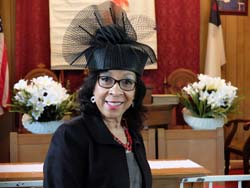
Nomzamo Iyanu embraces the hat-wearing tradition herself, which is no doubt helpful in marketing hats to her customers. She tends to wear hats to work and to festivals and other community events. She observes, "I think it completes a suit. And I think that's something that people saw, coming up, that makes you look complete. And you're, I don't know, a serious church lady if you wear a hat. I like them because it's fun. It makes me look different, you know? And that's why I like them. But again, I wear the fun ones, the different, fun, funky hats. And sometimes people wonder, what is that?"
While some women experiment with wearing an occasional hat, Jacqueline Jones has wholeheartedly revived the tradition in her own life. Having grown up with a mother, aunt, and others who regularly wore hats, she has found hats to be emblematic of that generation, especially when she began losing her elders. She explains:
At one time, I was experiencing some challenges in my personal life. Sometimes when you are going through certain things in life, you look for something to give you comfort, or to help make sense of your situation. And I was very close to my family—the women in the family, especially. What they stood for was so meaningful to me at that time, and I wanted a pick-me-up, I guess. So, mimicking the way they carried themselves with their hats and matching attire made me feel very good about myself. I found that no matter what else was going on around me, emulating the elders' style and traditions had a way of making me feel good, inside and out. Also, when I dressed this way, the elders so appreciated it, which was another reason to wear the hats and the suits.
Jacqueline's upbringing fostered firsthand appreciation for the women in her family. Her biological mother died when she was very young, and she was raised, in part, by an aunt who ultimately became a mother to ten children—her own and those of two sisters who passed away. Jaqueline's aunt—the person to whom she refers as her mother—made sure that all ten children were clothed and fed, and she was always there for them when they came home from school. She instilled in Jacqueline the importance of acquiring an education, so that she would always be able to take care of herself. Looking back at her childhood, Jacqueline realizes that her aunt never showed sadness and never complained, but modeled strength and dedication in caring for her family. Jacqueline also realizes that her own generation's successes have made their elders' sacrifices worthwhile. She now feels a "joyous hurt" to know how much she was loved as a child.
As she embarked on her hat-wearing journey, Jacqueline visited several local millinery shops in search of hats to match her existing wardrobe. She began getting out to ladies' auxiliaries and other occasions and noticed other women matching their outfits and taking it to the limit, so she followed suit. Through her sister-in-law, Nomzamo Iyanu, Jacquie ordered special pieces for her wardrobe.
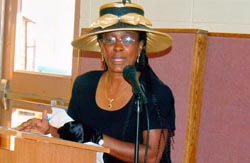
As she got deeper into her practice of wearing hats and matching her apparel, Jacqueline found that people turned to her for information about the place of hats in African American history and heritage. A library science professional by training and a passionate historian, she compiled research for a PowerPoint presentation on hats, discovering in the process information about Black Codes3 and the Tignon Laws which at one time prevented women of color from wearing hats. Combining church traditions, African American history, and her own professional focus on literacy, Jacqueline developed a hat-themed, intergenerational tea, which she offered in conjunction with Women's Day. Since she was adding the tea to Women's Day, Jacqueline sought and received approval from the church elders.
Jacqueline invited girls and women of all ages to attend the tea, which included a display of children's books featuring hats and her PowerPoint on the history of hats. Participants of all ages were encouraged to wear hats. Girls and young women borrowed their mothers' and grandmothers' hats, and received their first porcelain tea sets. The program was so successful, Jacqueline has presented it at various area churches and at conferences, including Shiloh Missionary Baptist Church, the Louisiana Library Conference, and the Fourth District Association on Progress. The program incorporates several of Jacqueline's passions and conveys the message that, "It's okay to be a girl. Your grandmothers wore hats, and this is why it was important to them. My hope was to encourage participants to wear a hat every once in a while, to honor their grandmothers. Because at one time, the black woman could not wear a hat."
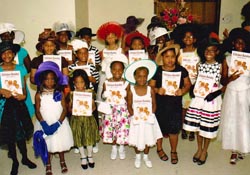
When she first began offering her hat program in 2012, Jacqueline became aware that younger women had gotten away from wearing hats to church. Seeking a reason, she learned that this was due in large part to the growing tradition of wearing braids, which the younger women did not want to cover with a hat. Jacqueline learned that most young women only wore hats to cover a bad hair day. But when they told Jacqueline, "You can't wear braids under your hat," her response was an emphatic "Yes, I can."
For Jacqueline, researching, developing, and sharing her hat program has had broader cultural significance, offering an opportunity to "pass this tradition on to another generation. It's a way of going back in history and simplifying things for people, so that they can understand our heritage." On another level, her program crystallizes the personal meaning that motivated her research, which potentially resonates with others. For Jacqueline, wearing hats and the related research sprang from her need to connect with her elders. She hopes that her research and public programs likewise inspire others. She reflects:
My elders were such special women. And when you're alone and life's circumstances or your family issues challenge you, you know not to just lose it. You can go back and remember what your elders would have said. And you can contain yourself. You can imagine them telling you, "It's just life. Deal with it and move on." It's not like whatever is bothering you didn't happen, but you must move on. Make it work.
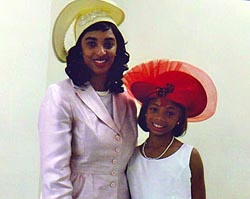 An aunt with her niece attending a hat show organized by Jacqueline Jones. The niece is adorning one of her great-grandmother's Sunday hats. Photo: courtesy of Jacqueline Jones.
An aunt with her niece attending a hat show organized by Jacqueline Jones. The niece is adorning one of her great-grandmother's Sunday hats. Photo: courtesy of Jacqueline Jones.No two women handle a situation the same way because the little personalities in another woman's family are different from mine. Everyone is different. When seeking guidance to navigate life's challenges, you can take others' advice into consideration but you always remember what your elders told you. Mine would say, "Take your time. Take your time in your decision. Because in the end, it's not you that matters, but it's this life that goes on." Education was always just so important to us, and knowing how to take care of yourself. And it's not so much that they talked about it, they showed it, they lived their beliefs through their actions. And that's what I think you remember most. They had their standards. And I like that. Even though I haven't reached those standards yet myself, I'm still trying to get there and I have a goal towards which to strive, you know? The hats embody that for me.
Hat Trends in the Media
Clearly, there are societal, cultural and personal factors that account for generational trends in hat-wearing practices. According to those interviewed, the "come-as-you-are" movement welcomes a more casual dress code as a way of transcending socio-economic barriers or alternative fashion preferences that might otherwise keep people from attending church. The come-as-you-are dress code, to some, levels the playing field and makes church a more inclusive institution.
Also, as noted earlier, many contemporary African American women favor wearing more elaborate hairstyles than their mothers' generation, and may not want to cover their hair with a hat. Further, the opportunity to visit the beautician regularly signals a societal shift, as African American women have increasingly had access to higher education opportunities and better-paying professional careers.
The reasons why some African American women may now be donning hats or tignons are as complex and varied as those that led to the decline of the tradition. Among the explanations for a recent revival in hat-wearing is the media and its influence on our lives. Since the days of Jacqueline Kennedy's iconic pillbox hats in the 1960s and before, the media has played a role in driving styles and trends. Although hat-wearing has generally been a waning tradition, milliners report a renewed interest in hats following the 2011 English Royal Wedding between Prince William and Catherine Middleton. Many in the community watched the wedding, reveling in the pageantry and the abundance of hats that were part of it.
Among the styles that made a splash at the wedding, fascinators worn by the bride's sister had a far-reaching fashion impact. Following the wedding, customers began seeking fascinators in Baton Rouge hat shops.4 Tony Aguirre of Variety Fashion did not watch the Royal Wedding, but her customers told her about it and began asking her for this new kind of hat. They described a design that was not a full hat, just a hat band. Bewildered, Tony called her garment industry contacts, asking, what is going on? The manufacturers were already in the loop and were able to fill Tony's orders for fascinators. Tony remembers that they sold like hotcakes! She observes that younger customers wear fascinators for weddings, showers, girls' day out, and similar occasions. Fascinators provide a way for younger women to ease into wearing hats without sporting the larger, showier crowns of their mothers' and grandmothers' generations. Not only do they make a more modest fashion statement, but they also are more affordable.
First Lady Millie Green watched the 2011 Royal Wedding in its entirety. She is aware that many in the community watched the wedding. She chose to watch it because she has an enduring affection for Lady Diana, whom she remembers as kind-hearted. As she watched the wedding ceremony and festivities, Millie felt like part of the family, a guest at the wedding in her own home. She was dazzled by the array of gorgeous hats worn by Queen Elizabeth and many of the wedding guests. Not only did Millie find the hats beautiful, she also felt that the women at the wedding were sustaining the British hat-wearing tradition. Following the wedding across the ocean, Millie noticed that women began wearing more hats in her home community, especially the fascinator-style hats. She reports that the fascinators are favored by younger hat-wearing women. She observes, "They're not the big ones and they're not the medium ones, they're the ones that say, 'Look at me, I have style.'"
K Dickerson of Four Seasons boutique noticed renewed interest in hat wearing following the Royal Wedding. Fascinators became popular at her shop, especially for less experienced hat-wearers who did not want to wear a big hat to church. She notes that her younger customers might also wear the fascinators to a Saturday morning tea or a bridal shower.
At her boutique, Nomzamo Iyanu likewise experienced the impact of the 2011 Royal Wedding and the ensuing fascinator craze. She also remembers another historic fashion sensation sparked by the hat that soul singer Aretha Franklin wore for her performance at President Barack Obama's 2009 inauguration. Although there is not an official name for that hat style, many of Nomzamo's customers came in asking for, "'the one that Aretha Franklin had on at the inauguration." Nomzamo's sold many of those hats after the inauguration.
Although there was not a name for the particular hat design, Nomzamo points out that Ms. Franklin's hat would be considered a "ring hat," alternately known as an "open crown." As its names suggest, a ring hat fully circles the head but is open on top. The hat is a basic ring, but it can be adorned in many ways. Nomzamo thinks of the ring hat as a "first-time beginner's hat." A woman might begin with a ring hat, and then venture into hats will little rims.
Although cultural and fashion trends will always come and go, it all comes down to choice. Today, people can draw upon their heritage, wearing anything from an elaborate tignon to a fascinator or ring hat, or even a large, showy crown, while many prefer to keep the focus on their hair. Within each generation, individual women convey something of their identity through their own personal style. Reflecting on change and continuity over time as seen in women's hair and hat adornments, Susan Thornton suggests, "It's a cultural tradition that we've carried on, in some aspects. We just wear it differently."
Hat-wearing advocate and historian Jacqueline Jones reflects, "It's incumbent upon our generation to keep our traditions going." She is aware that in times of economic stress, some believe that thinking about fashion puts the focus on the wrong thing. But, Jacqueline explains,
It's not merely a question of looking good for its own sake or impressing others. If you explore history, we've always been a people who adorn themselves. Even from the times of ancient Africa and Egypt, we've always adorned. Each culture has its own particular values and practices. These customs are neither good nor bad, it's just that different cultures have different ways of doing things. And I think there is a connection between our historic heritage and our more recent hat traditions. For example, I've looked into the ancient history of the very first hat in human history. It was an animal skin, among the Greeks. I am still researching these connections.
Jacqueline's research has revealed that there has often been social significance to hats—what they symbolize and who is allowed to wear them. She feels that even as people today may be getting away from their customs, they can still remember their origins. She feels it is important for people to be informed about the place of hats in African American history. She notes, "At one time we did not have a choice—but we have a choice today."
Fashioning Identity: The Language of Hats
Adornment is part of the general language of dress. More than the obvious visual and aesthetic presentation, it is a symbolic platform for the expression of the personal and social self. Sometimes dramatic, it is just as likely to be a subtle and nuanced message that reflects and influences the wearer's mood or sense of self. African American women have adorned themselves through their clothing, hair, and accessories, in ways that have created status, respectability, power, and creative expression. They have used adornment to affirm their self-worth, to assert their identity, and to reinforce a sense of communal solidarity.
—Elaine Nichols
From her research on the role of hats in African American history, Jacqueline Jones concluded that, "when you are denied the right to do something and then you have the freedom to do it, you take off with it. And I think that for the black woman, the ability to wear a hat helped to restore whatever pride and dignity was ever taken away from her. That's how I see it. She took that pride and dignity back, just by wearing a hat."
Jacqueline was brought up by women who believed that people should look their best when going to church. This was not an impetus to spend money unnecessarily, however. Jacqueline's mother was a seamstress who sewed most of her family's clothing. Jacqueline explains, "Especially when black women dressed with their hats, they evoked such a dignified feeling, as if to say, 'The world can look at me one way, but I see myself as something better.'"
Although they may not be aware of Tignon Laws, for women of Jescenia Crenshaw's generation and before, wearing hats and fancy attire on Sunday and special occasions provided contrast with the rest of the week. Long after the Black Codes were repealed in Louisiana, the prevailing laws enforcing segregation in the Jim Crow South "institutionalized a number of economic, educational, and social disadvantages" that impacted people's lives on every level.5 Both Jescenia Crenshaw and the late Inez Scott, Susan Thornton's biological and adopted mothers, respectively, were domestic workers. Growing up during the 1950s, Susan witnessed firsthand the importance of hats and dressing for church in her mother, Inez Scott's, life. As an adult who has experienced cultural and socio-economic change in her own lifetime, Susan reflects on the meaning of dress for her mothers' generation:
They worked to take care of their families and they worked to look good. That's all they had. They had the children—she had us. Of course, she had my daddy. But she needed something for herself. Sunday was her day to look good. She didn't look like anybody else going to work to clean, on that day. It was all about the individual. So, they had an opportunity to shine through what they wore going to church. That was their day. They didn't miss church, number one. But that was their day for their personal recognition. That was their day to say something to someone. You're working in someone's house all week, who are you saying something to? Who's talking to you? You're taking care of kids, you're washing their clothes. That's what's you're doing. So, what kind of conversation do you have about uplifting you? "Oh," you know, "you did a good job in cleaning my bathroom?" No. "You took really good care of my child, while your other children are at home."
So Sunday was their day to say something positive, that was their day to look good, to wear a dress, because they wore their uniform, their pants or dresses to work during the week. Sunday was just their day for everything. They were either the mistress of ceremony for a particular program, or they were the church secretary, the church treasurer, and they had to get up in front of everybody and they had to give a report. They made announcements. So you saw me and you heard me. It was just your day. Mm hmm.
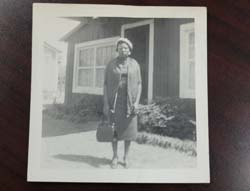
As aesthetic and cultural practices shift along generational lines, the decision to wear a hat is itself a form of communication. There can be dissonance among those who favor wearing a hat and those who do not see value in this practice. Talking about the hat that Aretha Franklin wore to President Barack Obama's inauguration, Nomzamo Iyanu points out, "The media wasn't ready for that hat. That was like, whoa! But that's what you see in the black church, hats like that, you know? And for her to wear it at that occasion, she was saying, 'This is a fancy hat. Take note. This is a special occasion, and I'm wearing a hat.'"
Jacqueline Jones remembers seeing a comedian on television poking fun at black women and their hats. Jacqueline's responds,
The woman who has decided to wear a hat could care less. She's already been marked, it has already been said, I'm not worthy, and I've shown through my life's experiences that I am worthy. So it matters not. I hope they had a good laugh, but it was just a different kind of woman who wore hats. You knew who to play with and who not to play with by the hat. It preceded them, it was their personality. And when you walk in, you have a hat on in church, eyes go straight to that lady. And it's not like they're looking for attention, it's just . . . God said cover the head and you just had fun with it.
For women of the hat-wearing generation, not only does a woman's Sunday finery embody her individuality, dignity and beauty, but within hat-wearing traditions there is a language of hats—a code in which colors, styles, and wearing practices convey information about a woman's sense of self and her place in society. Through this language, women can speak to others in the community. In the black Baptist Church and the black Methodist Church (AME), women play important roles in the congregation as deaconesses and stewards. Dafiney Self relates that women who serve as church stewards wear white. From her childhood she recalls, "They had their little white hats on, to match their white outfits." Dafiney explains that stewards are appointed. They work in the church and out in the community providing such services as tending to those who are sick, helping families make arrangements for baptism and preparing communion at church, among other duties.
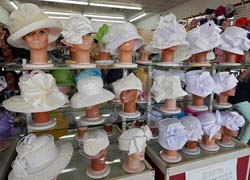
According to Millie Green, deacons and deaconesses help take care of church business. They tend to congregants who are sick. They also address maintenance and repairs of the church building, and attend to church finances. These responsibilities help free the pastor to attend to the Word of God, as Millie explains. Congregation members may express interest in serving as deacons or deaconesses, but ultimately it is the pastor who appoints people to this role. According to Millie, deaconesses often wear hats to church. They can be seen sitting on the left side of the church, up at the front. All of the milliners interviewed for this project have customers who are deaconesses, stewards and ushers; these women shop for attire corresponding to their roles.
Nomzamo Iyanu refers to hats as a form of communication, a "conversation" that reveals much about the wearer. As a milliner, she tunes into this conversation in order to help customers find the right hat for each personality and occasion. Nomzamo comments on this process:
"I have to look at the styles; a hat has to talk to me. Because I know how my customers want to 'talk.' . . . There's a certain conversation, you know." According to Nomzamo, the conversation goes something like this.
"Well, this is a serious hat, you know? I'm a serious person, and this is a fun hat. And I'm bling-blinging now. You can watch me, because I've got character, you know?" So with those kinds of conversations, my customers are talking, letting you know that they're elegant women, you know, and fancy. So you have those kinds of conversations going on. The hats really talk. . . . what they are saying depends on the person and the statement that they're trying to make.
When the hats "talk," color is a part of the vocabulary. Naturally, women choose hat colors based on their personal preferences and the need to match a particular outfit. Tony Aguirre of Variety Fashion has noticed that some of her customers favor blue and purple hats, as these colors convey a sense of royalty. Not surprisingly, the time of year generally dictates the color of a hat. According to Jescenia Crenshaw, people tend to wear black hats in wintertime. Black is not only a cold-weather color, it goes with everything. Susan Thornton remembers of her mother's generation that hats were seasonal—the color and tone of a hat matched the time of year. A woman would not wear a yellow hat in the fall, for example, or a dark hat on Easter Sunday. She recalls, "We called it 'our bonnets.' And we would sit around on the front porch and my mama would refer to it as her Easter bonnet. They're hats at all the other times. But on Easter, it was their Easter bonnet."
Millie Green feels that the bright colors typically worn during the spring and for Easter express seasonal and spiritual significance. In synch with the both natural and religious rebirth, the bright colors represent "A new beginning, a new start." She reflects,
I think in the Spring, you see the bright colors. We don't want to take away the real reason for Easter. But traditionally, it is one of those holidays when you do something special, you know, with your little Easter dress and shoes and purses, with the bright colors and everything. I think today, we have kind of lost the concept of what Easter means. You know, we have picnics and parties and so many other things, but don't necessarily give that real reverence to what Easter is really about. Because if it had not happened, then we all would have been lost.
During the spring and summer months, Nomzamo carries more hats in lighter shades—white, ivory, and peach are indicative of warmer weather and the need to keep cool. The color of a hat or other attire may also communicate one's role in a wedding as a member of the bridal party, or the theme or tone being set for a particular occasion. Often, Nomzamo's customers come into the store seeking a hat or other attire in a very particular color or shade, as prescribed by a bride or someone coordinating a church event. Sometimes the name of a particular shade or color adds a challenge to the search. Nomzamo relates that often, the bride:
gives the bridesmaids or the family member certain colors: "These are the colors you can wear. Don't ask me about any other color, just make sure you're in one of these colors." They come in here asking for coffee, and it looks like champagne. And I wonder, why don't these companies provide a color, a real color, not all these names, you know? Champagne, what's the other? Eggplant and mocha. Just give me beige! It makes us crazy. I just tell them, okay, alright, we'll see what we can do. They'll ask, "But does it say that shade?" And I tell them, "No, it's not going to say that, but if it looks like it, that's what you want." It makes our work hard. It's funny to me though, it makes me think that somebody must have been hungry when they were making up the names of these colors. You know, they were thinking of food. Can you imagine a "mango" color? Mangos are different colors, depending on where they come from, different times of the year.
Sometimes customers bring a fabric swatch to match, which helps narrow the search!
Nomzamo keeps white hats in stock much of the year, as they go with almost anything and because there is on ongoing need for white hats among her customers. In addition to the hats and apparel regularly worn by stewards and deaconesses, white is the color prescribed for Women's Day in church. Nomzamo is noticing a slight change in Women's Day attire, as new generations are participating in this tradition. Nomzamo's sister-in-law Jacqueline Jones explains that on Women's Day,
Everyone is in white, including the little girls. You can accent the white with a color. It used to be all white. White is still your basic color. The young women like Women's Day, they don't mind it, but they want to bring in some different colors. This year, they wanted to bring in magenta. And the elder ladies said, "What?!" Most times, for economic reasons, if it's before Easter, they'll buy a dress a little girl can wear for both occasions, so they don't have to go out and buy another one.
In addition to Women's Day, other church occasions for which women may be asked to wear a specific color include a church or pastor's anniversary, or a Baptist Convention, for which attendees travel out of town. Tony Aguirre always learns the color themes for special events, as her customers come to her boutique in search of outfits for these occasions.
Adding accent colors like magenta or turquoise to Women's Day whites signals slight shifts in tradition. Other changes in color codes are more dramatic. When Tony Aguirre first became a milliner, dark colors like black and navy were the norm for a funeral, indicating mourning and the solemnity of the occasion. Gradually, she has seen a transformation in this tradition. She recalls being shocked one time when a customer came in looking for a pink suit for a funeral. Tony remembers saying "'No!' I said it just like that, but then the customer said, 'Yes. Now we're going to get away from the tradition. We want color.'" One motivation behind this change is the expression of respect or support for the deceased by wearing a color that relates to a particular illness, such as pink for those who have died from breast cancer.
Color may also be a way for families and friends to personalize a memorial service by honoring and showing their love for an individual. Tony finds that sometimes families dress their loved ones for burial the way they dressed in life, hat and all. Tony reflects, "So, the tradition is changing. The old traditions are changing, and new traditions are coming in. So, black does not sell as much anymore. Still, the old tradition is there, people still wear black for a funeral sometimes. But there are more colors now, like white, grey and silver. Some people wear blue. So even for funerals, we are seeing more colors." One aspect of dressing for a funeral that has not changed with the color scheme is hat size. People continue to favor smaller, more modest hats for funerals.
Nomzamo Iyanu reports that her customers regularly select colors as a visual reference to a loved one, whether for a funeral or other occasion. She explains,
I think people do that because it relates to somebody else, a family member. Because people will wear any color, like lilac, you know, in remembrance of someone. So it's not unusual. Somebody just the other day was buying black and white because it reminded them of some family member. Any time they went out and it was something special, they wore black and white. So they wanted an outfit, and it had to be black and white.
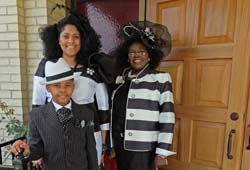
Fieldwork conducted during the week leading up to Easter offered opportunities to learn about individual color symbolism in hat wearing practices. In what might seem like a departure from the whites and pastels often associated with Easter and spring, some people wear colors that have personal or religious significance. Dressed for Palm Sunday services at Shiloh Missionary Baptist Church, the Gautier family cut a striking portrait in their coordinated black and white attire. Brenda Gautier explained that they were wearing white to honor her mother, who always wore white, and black to honor their heritage. Later that week at the Dr. Leo S. Butler Community Center, the Sensational Seniors group held an Easter program that included a Hat Day and fashion show. Evangelist Lydia Tucker wore a red and black outfit, top to toe, that tied into Easter's spiritual meaning. For her, the color black represents mourning the death of Jesus, while the color red symbolizes the blood he shed for us all.
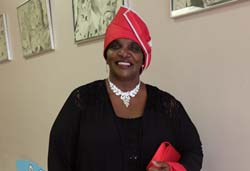
Taken in context, hat-wearing traditions offer women an opportunity to express their individuality, their roles and relationships in the community, their cultural traditions and their place in broader society. Some of the language of hats is mutually intelligible among members of a shared community, where prescribed colors and styles speak to specific occasions or roles. In other cases, a hat color may be understood exclusively within a particular family or religious or civic group. At the individual level, a hat's meaning may be known only to the wearer. Regardless of their frame of reference, hats contribute to these multiple conversations, revealing much about the women who wear them.
An Economy of Style: Wearing, Buying, Maintaining, and Transferring Hats
Hat Rules: Conduct for Wearing Hats
The language of hats may be based on membership in a family, church, community or culture. This language is not written down—it is known and understood among those familiar with the tradition and the codes. Research conducted with milliners and community members revealed that there are other unspoken (albeit commented upon) "hat rules," which relate to how a person should wear a hat. For example, a person should not wear a hat with a brim wider than her shoulders. A person should not wear a hat that is a darker shade than her shoes. A person should not wear a large hat and sit at the front of the church. Of course, as with any rules, these are sometimes broken!
Probably the most compelling rule dictating the wearing and purchasing of hats is the edict against wearing the same hat to church too often. What constitutes "too often" is a matter of degrees and to some extent depends on a woman's personality and resources. Women naturally shop where the price points match their budgets. Yet, whether they shop at J.C. Penney's or a boutique, women who wear hats must continually have something new wear to church and to social occasions. It simply will not do to wear the same hat to church within several weeks, months, or even longer. A new outfit can be achieved, however, by pairing the same hat with a different dress or suit and other accessories.
Looking back to her childhood, Jescenia Crenshaw notes changes since her mother's and grandmothers' generations.
Oh, the hats that they wore—they were very small, very small hats. Probably that's all they could afford. And they would wear that one hat fifty years. Every week, every week, every night, every day, whenever they go to church. Because they couldn't afford another hat. They would wear the hat in the summer or the winter. And back then, they were so poor that nobody would look at you and say, "Well that old hat she's got on, she wore that last night." But now, you've got to change hats. . . I do. Because they would say, "Well she had on that hat the other day. She had on that hat last week." So, it is so different now. The world is just so different now.
Thinking about why this might be the case, Jescenia explains that generally people have more money today, and there can also be a sense of good-natured rivalry.
You know, they see you—maybe they might see a hat that I wear. When I do wear a hat, the ladies do tell me, "Well that's a pretty hat you've got on." I say, "Well thank you very much. Well, do you want to borrow it?" That's what I say, like that, you know, we just say that. They don't want to borrow it. And then if I see them with a pretty hat on, prettier than mine, I'll tell them the same thing.
This gentle teasing is a play on another hat rule: women generally do not loan or borrow each other's hats. How often would Jescenia wear the same hat?
Well, like I'll wear it for Easter, okay? It'll be a while before I'll wear it again because I have a lot of hats. I won't wear it back like the next Sunday or the next Sunday or the next Sunday—I'm not going to do that, uh uh. The next time, I'll wear a different hat. We don't wear the same one. . . Everybody's going to wear another dress, another pair of shoes, another purse. That's how we do it.
Research for this project was conducted during the weeks leading up to Easter. In preparation for the holiday, Jescenia's daughter, Susan Thornton, bought her a new gold-colored hat. Jescenia might wear the same hat again in July, but with a different outfit. She explains, "I will mix it up, uh huh. Because that one hat, that color, I can wear it with many, many dresses." Jescenia gets a new hat and dress to wear for Easter every year, as well as for other holidays, like Christmas. When she wears her new hat again in July, she'll remember it as the one that Susan bought her for Easter.
Susan Thornton remembers that her biological mother, Inez Scott, wore her hats in rotation. "Well, let's say if she would wear a hat in June, oh she may not wear that hat for three more months. She can't wear the same hat! No!"
Asked whether a woman would wear the same hat to church two weeks in a row, Nomzamo Iyanu responds, "Oh no! That would be crucifix! No, no, no, they don't do that. They don't wear the same hat—no." Nomzamo explains that her customers will not wear the same outfit within a year. In order to accomplish this, they "buy more than one outfit when they come in, so they rotate stuff. Like certain things they'll wear this year, they won't wear next year, at all. I mean, they're looked at every Sunday. They sit in a certain seat in the church. Are you crazy?! No, they don't roll like that."
Not only is it considered bad form to wear the same hat or outfit too soon, but women strive to be distinctive in their dress. Understanding each customer's style and her desire to be unique is a vital tool of the milliner's trade. The milliners interviewed for this project take notice of what their customers buy. Nomzamo Iyanu points out that this type of personalized service distinguishes boutiques from the larger chain stores. She shares:
Well, it's challenging because if somebody else from the same church comes in, I need to remember that. And I need to remember what they purchased, and make sure that the first lady doesn't have the same thing that they have. Now you know, that's a lot of work. Dillard's doesn't have to do that, nor Macy's! They just sell it, you know? And those little things make us special. But it works you to death. And you don't even have the conversation, you know? I'll just say, "Somebody else at your church has that one—you don't want that." And they'll say, "Oh, baby, I'm so glad you told me because I sure didn't want to break out in there." So you try as much as you can.
Since other boutiques may sell the same attire, however, it's inevitable that people sometimes show up for church or other occasions in the same outfit.
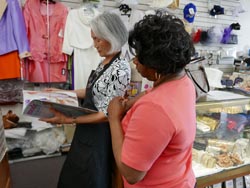
Tony Aguirre also tries to help her customers to look distinctive. Because of her specialty in church wear, church staff occasionally order attire directly from her shop for a special event. Sometimes Tony's customers do not tell their friends where they shop, to prevent them from buying the same thing. Tony remembers a customer who was seeking a black outfit for a particular function. Since the church wanted everyone to shop in the same place, ultimately this customer was obliged to reveal her source. In this case, church members bought different dresses but in the same color. Tony says, "I can't provide the same dress. Friends tell me there's a function going on. So sometimes I ask, 'What function are you going to? Because I don't want you to buy the same dresses.' So most of the time they never have the same dresses, because I know my customers." Tony knows which churches her customers attend and she stays current on the functions for which they are shopping. Another strategy for preventing her customers from buying the same outfit is not stocking too many of the same dress or suit. Tony adopted this tactic when her customers began asking her how many of a given outfit she carried in the store. She is ever learning from her clientele. She says that she does not want them to come back and be mad at her.
Buying Hats
Nomzamo credits her grandmother as her inspiration for dressing distinctively and carrying unique clothing in her shop. From her childhood in Ville Platte, she remembers accompanying her grandmother to shop for hats.
Opelousas had this store called Abdalla's. And they would go there and shop for fine clothes, you know, the nice clothes. And she would buy hats. And you know, back then, I didn't recognize it because I was young, but black people couldn't try on hats and clothing in the store. You had to look at it and then if that was your size . . . but I didn't know that when I was that age, going with them, I just noticed she would buy hats there.
Growing up in the 1950s and 1960s, Susan Thornton remembers going with her mother to buy hats. The salespeople in the shops knew Susan and her mother, because as African Americans, unfortunately, they could only go to certain stores, for both economic and social reasons. Susan recalls,
So it was Sears or J.C. Penney's, and also Montgomery Ward. They weren't going to the fancy stores like today's Maison Blanche or Dillard's. That was just the way it was back then. So they wore the hats from the stores where they could shop. Or ladies would come around and sell the hats, as they would with fruit or anything else. They came door to door. There was nothing like a Hiltons for African American people back then.6 If there was, they didn't know about it and they couldn't have afforded it.
I would go with her to buy the hats when I was a little girl. Again, my mama couldn't read or write. So I would have to tell her how much it was. My mama could sort of write her name, a little. But that was it, she couldn't read anything. And even if it was 20% off, she knew if a sign was up there, that meant something. And she would say, "Baby, what does that say?" I said, "That's 20% off, or that's 10% off." So she knew that meant something. But she didn't know what it was.
And so, that was my job, coming up, I remember, in elementary school, mostly middle school and high school, to help her figure out how much that was off that hat. You know? And of course, she was buying it back then because I didn't have any money. But when I started working, I started buying. Oh yeah, it was a pleasure. It was a pleasure to buy for her. . . . We kept her in hats.
Was there a ritual when her mother bought a hat?
I think Easter and Mother's Day were the biggest but I think Mother's Day, if I had to say. But it was always about the holiday, it was always about the occasion—where am I going? What do I want to look like? And who do you think's going to be there, that's going to try to out-hat me, too? Oh yeah. . . There was a little method to the madness. "Oh, I heard sister so-and-so is going to be there, and she always has this hat. Well." They had the little competition going-healthy competition, I think.
These days, Susan buys new hats for Jescenia Crenshaw, her biological mother, for Easter and other special occasions. Although the two go shopping together, Jescenia observes that Susan knows her taste in hats so well, she can often pick out the right hat for her. Jescenia's other children sometimes send her money to buy a new hat.
Maintaining and Storing Hats
Serious hat wearers take good care of their hats, storing them in hatboxes and plastic bags to keep them clean. Jescenia Crenshaw believes that she currently owns about a hundred hats. She is particular about the way she stores and arranges them. Her hats live in the top of her clothes closet. She is the only one to handle them, taking special care to protect the hats with decorative elements like feathers, flowers, or bows. When stacking these hats on closet shelves, Jescenia always places them on top to prevent them from being mashed. She organizes her winter hats and summer hats separately. She positions the hat bags so she can open them easily and peep inside to see what is in each bag. Her system expedites getting ready for church or other occasions, as she knows where to find a particular hat.
Milliner Tony Aguirre reports that some of her customers have up to one hundred hats. With collections of that size, these customers may have a dedicated closet in their homes just for their hats. Often, these women label their hats and know where to find each one. Most women have their own system for storing and accessing their hats.
Millie Green remembers that her mother always stored her hats in hat boxes. When she bought hats, they came from the store in boxes. The boxes were square, and sometimes they were decorated with flowers or images of people wearing hats. Millie's mother stacked the hat boxes in her closet. For church, she would pull out the hat she wished to put on, changing it out to wear a different one each week. Otherwise, people would notice.
Susan Thornton's mother, Inez Wilson, also kept her hats wrapped in tissue paper, in hat boxes. Every hat had a hat box. Susan estimates that her mother had between thirty and forty hats. They were stored on the top shelves of several closets around the house. Susan does not know exactly how her mother sorted the hats, but she remembers there being separate winter and summer areas.
Nomzamo Iyanu recalls that her grandmother had hat boxes all over her home—in her closets and underneath her bed. Hat boxes were once universal among hat sellers and customers. Hat boxes provide a safe and convenient way to transport and store hats. Today, hat boxes are much less common. Often, manufacturers send hats to the milliners wrapped in tissue paper or a plastic bag, in a shipping box. This is especially challenging for milliners and their customers where large, wide-brimmed or elaborate hats are concerned.
On one occasion when she was selling an especially large hat, Nomzamo called the hat company and said, "Either send me a hat box or take that hat back—because my customer has to have something to put that hat in. I cannot sell her a hat without a hat box to put it in." Nomzamo could not find a box big enough for the hat. Ultimately, the company sent for the hat and gave Nomzamo credit. Now, the company knows not to send Nomzamo's boutique a hat without a hat box. Nomzamo remarks, "A serious woman who buys hats? You're not selling her a hat without a hat box—it's not going to happen. You know, that's an insult."
Tony Aguirre has some customers who will not buy a hat without a hat box. She navigates this issue by ordering hat boxes separately and keeping them on hand as a courtesy to her customers. She understands that hat boxes are heavy and expensive for manufacturers to ship. She covers the cost of the hat boxes, as she knows they are important to her customers.
Hats in Circulation: Transferring Hats
Although women take good care of their hats to prolong their usefulness, there may come a time when they are ready to let go of a hat, perhaps when it has gone out of style. Women have multiple options for disposing of hats they no longer wear. Jescenia Crenshaw throws her cast-off hats away. Formerly, she gave away hats she no longer wore, but these days she does not pass along her hats and other items, as she is afraid the recipients might feel she is looking down on them.
Many hat wearers, however, find ways to recycle their hats. Susan Thornton remembers that her mother, Inez Scott, would give her hats to someone who lost her hats in a fire, for example. If there was a mission at church, her mother would donate a few hats. A Four Seasons customer who is a first lady shared that she has a walk-in closet in her home that holds her hat boxes. The hat boxes are marked with the color and season, for example cream for summer, and so on. This woman explained that she has a deal with her husband. For each new hat she brings home, she donates two hats to her church, where there is a room to store donated clothing and hats. People can come and take what they need. At some churches, this arrangement is referred to as a "closet." First Lady Millie Green explains how a closet works:
You bring your slightly used items, and we just hang them. And as people come and they need something, they can just select their sizes. Because if every member would donate something, you'd have a variety of sizes. In fact, Susan Thornton gave me some things, and I brought them to the church. And one lady told me, she said "Miss Green, I haven't been coming to church because I don't have any clothes." And I said, "Come here." So we went into one of the closets up front, and I said, "Take these. What size do you wear?" And she said, "Well, I'm in 12's, 13's, and 14's." And that's what Susan had given to me, so I gave them to her. And she really appreciated it.
Although she regularly attends another church, Susan Thornton is a "visiting member" of New Salem Missionary Baptist Church. She comes to New Salem for special programs.
When those who donate their clothes to the church closet see another member of the congregation wearing their former clothing, they are unlikely to mention it. Millie points out that calling attention to someone who is wearing another's clothing would be cruel, especially when that person is in need. Further, Millie thinks that women might not recognize their own clothing on someone else, out of context. She explains, "Once you put that outfit on, it gives a totally different look."
Death is another time when hats and clothing change hands. When a woman who wears hats passes away, the disposition of her hats is often serious business. Tony Aguirre observes that although some families might give away a woman's hats and suits to her church for a fundraiser, most often the hats stay in the family. Since they are more versatile in size than other attire, hats can more easily be worn by family members. Tony finds that some daughters keep their mothers' hats to remember them by, or they give them away, one by one, over the years.
When her mother, Inez Scott, passed away, Susan Thornton found that she needed to move her mother's hats out of the house quickly, as they were too painful a reminder. She knew she did not want to get rid of them, and she did not want anyone else to wear them. A friend from Alexandria came and took the hats to her home for safekeeping. Now, Susan can look at the hats whenever she visits her friend. One day, Susan plans on passing her mother's hats on to her daughter.
When her mother passed away, Millie Green's sisters acquired all of her hats. At the time of her interview, Millie was still deciding what to do with her mother-in-law's hats, but she knew she wanted to keep them in the family. She thought she might give them to her daughters, as a remembrance of their grandmother. Although in life, women seldom wear each other's hats, Millie believes that it is appropriate to wear a deceased person's hat as a way of showing respect. Millie's mother-in-law's hats hold special memories, as Millie used to accompany her to shop for hats. Millie remembers that her mother-in-law loved having family members help select her hats.
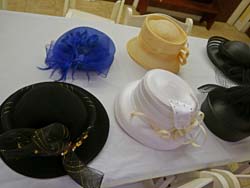
Hat devotee, advocate and scholar Jacqueline Jones often asks people what they do with their mother's hats after they pass away. As noted, women may own anywhere from fifty to a hundred hats when they die. Jacqueline has found that people may keep the hats, throw them away, or donate them to a second-hand shop. Jacqueline's ultimate dream is to establish a museum for black women's hats. Her idea is to have a place where everyone can deposit one of their mother's or other loved one's hats, for preservation and display, thereby creating a historic hat archive.
Jacqueline found inspiration for this idea in a display of the late former Louisiana State Representative Rupert Richardson's hats at the Louisiana State Archives. Representative Richardson was known to wear a different hat each day that the Legislature was in session and to always wear the right hat for every occasion. That the disposition of a woman's hats after her passing should be such a momentous consideration to loved ones speaks to their importance in people's lives. A woman's hats are so strongly identified with her personality and being, they become an extension of her to her loved ones, often holding a special connection after she dies. If she spoke with her hats while living, perhaps a woman's hats speak about her or for her when she is gone.
Faith, Beauty, and Pride: Finding the Balance
These captivating hats are not mere fashion accessories. Neither, despite their biblical roots, are they solely religious headgear. Church hats are a peculiar convergence of faith and fashion that keeps the Sabbath both holy and glamorous.
—Michael Cunningham, Crowns; Portraits of Black Women in Church Hats
If hats are a form of communication by, about, and among the women who wear them, these conversations take place on multiple levels. For some women, church attire may figure into their relationship with God, as an expression of their faith. The religious dimensions of hat-wearing traditions are multi-faceted.
Although they may be unaware of the precise biblical origins of their hat-wearing tradition, women have for at least several generations found spiritual significance in dressing for church. Dafiney Self observes, "Well I think it all has to do with religion, spirituality. And it's a matter of what we would call a custom, something that has been done throughout the years or generations." Like the elders who raised her, Jacqueline Jones sees the connection between dressing for church and spirituality. She remembers the values she learned from her mother's generation: "He wants your best. So, even if you don't have shoes, your feet should be clean and oiled and you should just look your best. That's what they believed. And so in holding to these beliefs, the elders could cover their heads and be in synch with what God wants, and at the same time feel good about it."
Tony Aguirre's more than twenty years with Variety Fashion have allowed her to witness generational transformations in the relationship between spirituality and dressing for church. Specializing in women's church wear and catering to an older clientele, she knows that most of her customers lament the current trend in church attire among younger generations. The come-as-you-are movement is intended to be more inclusive and to engage congregants who may not have the motivation or means to dress up for church. Yet Tony feels that dressing for church is itself an expression of faith. In spite of societal and aesthetic changes, she sees continued significance in looking good on Sunday. She shares,
My thing is, I want people to keep their traditions. And people, they're faddish, they keep on changing things. I say, keep the traditions, keep them going. And this younger generation, I want them to dress nicely to go to church, worship God, and not just go any old way to church. Because I believe in God as the highest spring, and I think we should give Him our best. I believe a person should dress nicely to go to worship.
Tony is herself a Jehovah's Witness. Although the dress code for her church is simpler than that of most of her African American customers, she shares their sensibility and sense of tradition about dressing for church. She says, "We don't bling-bling, but I dress nicely. I try to look nice." Of course, what constitutes "nice" is in the eye of the beholder. Within standards for appropriate dress, there are clearly different levels of formality as well as aesthetic preferences, ideas about modesty, and budgetary factors. Especially among older African American women who attend church, these standards are defined by cultural tradition.
Over her lifetime, First Lady Millie Green has been aware of the connection between devotion and dressing for church. She remembers that her mother's generation seemed comfortable wearing hats to church, even as they clapped and moved around during a service. Hat pins helped keep women's hats in place on such occasions. Asked whether the hat-wearing tradition has religious significance, she responds,
I think it does. Because there is a verse in the Bible that says that women should cover their heads. It's in the Old Testament. But we're living in the New Testament time, so I guess that's probably where it kind of breaks off a little bit. And I think the women in that day thought you should be dressed up because in our household, you could not leave the house unless you were dressed appropriately. You know, you didn't go out with your rollers in your hair, or not looking neat. So in the black Baptist churches, you were to dress with your nice dresses and your heels and stockings. And for those older generations, they really believed in that, in wearing those suits and really putting on those hats and looking very, very nice when they would go to church. And gloves, yes, yes.
My mom wore a hat every Sunday, every Sunday, right. And most of the ladies at the church did wear their hats. I think the thing was covering their head in reverence to the Lord when entering the House of God. And for example, once a month, on third Sundays when we have our Communion Service, the ladies will wear their communion caps, which are just lacy little caps that they put on their heads. People in our traditional churches put that communion cap on, on Communion Sunday. It's a piece of lace that just kind of flows.
Jescenia Crenshaw grew up with the hat-wearing tradition and has worn hats to church and special occasions for much of her adult life. It is part of her fashion and spiritual practice. She says,
Well, it seems like I am more content. And it's not that I'm, say, so dressy, with my beautiful dress on, shoes, purse, and gloves. It's just that I'm going into a house of worship. It's just that I feel like I'm going to worship God. And with that hat on, that just makes me feel so, so good—that's how it makes me feel. And without that hat on, I don't feel right in a house of worship. . . . All I've known all of my life is that I saw the senior citizens wear them. My mother wore them. And I decided I want to wear hats. It's not just to make you look good. It doesn't make you look any better with the hat on, or without the hat. It's just something I would say, for me, just worshipping God with that hat on makes me feel good.
While there is no question that wearing hats to church reflects one's sense of self and status within the church and broader society, there is also a sense that people must at the same time embody humility and reverence when attending church, to be part of the larger whole—the congregation and the religious community. For some, it's about striking the balance between looking one's best to attend church and not looking good solely for the sake of looking good. In the eyes of those who embrace the spiritual aspects of dressing for church, it cannot be about vanity.
Millie Green has pondered the balance among the different dimensions of dressing for church—glorifying the Lord, self-respect, and the social aspect of looking good in the eyes of one's peers. She observes,
Now, dressing and looking nice—I love that. I love to dress, I love to look nice. But I can't let that take first place or be on my forefront. It has to be put on the back burner when I come here. And I hope that that's the way other people see things. Because then your mind is clear, and you're not sitting there thinking, "Oh, I look so good." You have to release all of that.
There's this quote that I read recently that says, "When you walk into a room, you want all eyes on you." So, if you walk into a room and nobody looks at you, well then you look natural, just plain. But when you walk into a room, and there's that shocking effect, you know, that everybody says, "Oh wow, that looks good on her!" that comes along with having the right outfit—the right hat, the right shoes, the right purse, to give that appearance. But we don't want that to take the place of why you're at church. You know, you want to look nice, of course. But then the real reason that you're at church, is to praise and worship God. So I guess it all plays a part together.
There was a deacon here who used to say, "Don't get the big head." When you are looking good, you first look good for yourself. And if I look good for myself, it doesn't really matter what anybody else says. You've got to have that strong belief in yourself, and have that positiveness about you. But at the same time, people will tell you if you look nice. And I don't think we should let that get to us, where we think we're more than ourselves, we're above anybody else, you know? It's just, if we look nice-we look nice. And that is it. But when we're in church, when we walk in that door, we're supposed to leave all that worldliness outside. And when I say walk in the door, I mean walk in the door of the church. We're supposed to leave all the worldliness outside, all the evil thoughts that we may have. All of that, outside. And our thoughts inside this sanctuary are to be only on one thing—on Jesus Christ, who died on the cross for our sins. And if we could just get that into our mind, we'll have a such a hallelujah good time, you know? Good time.
For Jescenia Crenshaw, church attire not only figures into her relationship with God, but it also has bearing on her association with fellow congregants. When she arrives at church, she makes contact with her friends, being sure to greet everyone and shake their hands. Commenting on one another's Sunday clothes is part of this ritual. Jescenia sees this aspect of her experience in church as another way to embody her values. Among those who share the belief that dressing for church is itself sacred, acknowledging this shared aesthetic is part of one's practice, as is maintaining an attitude of humility and mutual appreciation.
To me, I think it's so wonderful, if you see someone with a pretty dress or a pretty purse, even if you see a man with a beautiful suit on, or some nice shoes, I don't see anything wrong with telling them how nice that is. Don't be jealous. Because God doesn't want us to be jealous of each other. God wants us to love each other. Be kind to each other. Help each other. And that is what I do.
Wearing a hat and dressing in one's Sunday best may be prescribed by religious belief and by cultural tradition, but there is also an individualized dimension to the relationship between dressing for church and spirituality. Especially at a time when not all women wear hats or "nice" clothing to worship, dressing for church reflects a personal choice. Women may feel the social pull to dress well for church, or not, but either way, they have their own reasons for doing so. There are "hat conversations" that take place within, as women make their own spiritual connections to their church attire. Their hats and clothing are an outer manifestation of an inner process. About her own practices and beliefs, Jescenia Crenshaw observes,
You asked me why I love to wear a hat, and I said that when I go to worship God, I feel like I should be fully dressed for Him, sometimes. And it just makes me feel good. I feel different, when I'm sitting there in church. Oh, I'm filled up, I'm full. I'm happy. I'm content in church. And I just love it. I love it. It just feels like, I don't know if God is there, or if He's listening? I do believe that He is there, that he is around me. I feel like that, in church because I'm worshipping him, I'm thanking Him for what He does for me. And I do that at home, too, but at church, it's different. Yes, indeed.
To me, I think that when you're going before God, in a church, I think you should look your best for Him. Your best for Him. Because He has fixed it so that you can have those things so that you can look your best. And so I think you should. Not at home—you can wear any old thing at home. It's your house. That's where you live. But church is where you're going to worship Him, thank Him for what He does for you. That's how I see it. I don't know any other way.
You're all clean and you've got your make-up on. Your hair is done up, and you've got on your earrings, or whatever you want to put on. And you're sitting there, and you're thinking of things that you have asked Him for, and that He has given to you, what he's done for you. That is how I do. That's me. I might not get everything I ask for. But I do get some things that I've asked Him for. I sure do. Because without Him, you wouldn't have anything.
From Jescenia's perspective, dressing well is a manifestation of her faith. There is a direct connection between her capacity to dress well for church and her spiritual practice. Her Sunday best and her relationship with God are inextricably linked in a symbiotic cycle. Within this connection, there is the larger significance of all that is provided, the prayers that are answered, the needs that are fulfilled. Millie Green sees this relationship in a similar light. She observes,
And when you really think about it? The Lord has provided this beautiful outfit for you, and you're walking and you're talking. You're able to move about. You may have your aches and pains, but at the same time, the Lord has blessed you with reasonable health and strength for you to walk into His house, and to give Him that praise. So, of course, you want to look good. But at the same time, you want to thank Him for providing this beautiful hat and this beautiful dress and these gorgeous shoes. And when you come here, you want to thank Him for providing, and for opening up your heart to feel that spirit and to hear that word that the minister is preaching, so that you can go out and share it with others.
Because when you feel good about yourself, you have a tendency to let go and to let that spirit come within you. It's like having a worry. And you're just worrying about something. And if you know that there's someone who can take care of all of this for you, just letting it go, letting it go, it helps. So when we come here, we give praises to God, from this Sunday to this Sunday, knowing that He's taking care of us and meeting all our needs. I didn't say "wants." He has met of all our needs, because there's so much we would like to have. He has met our needs. And so, we come here to give Him thanks for that. And when we know that, it's going to be alright. It's going to be alright.
Seen in this light, wearing a hat and looking one's best can heighten or complement spiritual experience, while expressing humility and an appreciation for having enough. As another form of the language of hats, this devotional plane represents a conversation with God, with one's fellow congregants, and with oneself, integrating the spiritual, social, and personal dimensions of the tradition.



